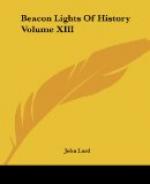The book reveals the man. The writer has no hope or repose or faith. Nothing pleases him long, and he is driven by his wild and undisciplined nature from one retreat to another, by persecution more fancied than real, until he dies, not without suspicion of having taken his own life.
Such was Rousseau: the greatest literary genius of his age, the apostle of the reforms which were attempted in the French Revolution, and of ideas which still have a wondrous power,—some of which are grand and true, but more of which are sophistical, false, and dangerous. His theories are all plausible; and all are enforced with matchless eloquence of style, but not with eloquence of thought or true feeling, like the soaring flights of Pascal,—in every respect his superior in genius, because more profound and lofty. Rousseau’s writings, like his life, are one vast contradiction, the blending of truth with error,—the truth valuable even when commonplace, the error subtle and dangerous,—so that his general influence must be considered bad wherever man is weak or credulous or inexperienced or perverse. I wish I could speak better of a man whom so many honestly admire, and whose influence has been so marked during the last hundred years, and will be equally great for a hundred years to come; a man from whom Madame de Stael, Jefferson, and Lamartine drew so much of their inspiration, whose ideas about childhood have so helpfully transformed the educational methods of our own time. But I must speak my honest conviction, from the light I have, at the same time hoping that fuller light may justify more leniency to one of the great oracles whose doctrines are still cherished by many of the guides of modern thought.
SIR WALTER SCOTT.
1771-1832.
THE MODERN NOVEL.
In the early decades of the nineteenth century the two most prominent figures in English literature were Sir Walter Scott and Lord Byron. They are still read and admired, especially Scott; but it is not easy to understand the enormous popularity of these two men in their own day. Their busts or pictures were in every cultivated family and in almost every shop-window. Everybody was familiar with the lineaments of their countenances, and even with every peculiarity of their dress. Who did not know the shape of the Byronic collar and the rough, plaided form of “the Wizard of the North”? Who could not repeat the most famous passages in the writings of these two authors?




